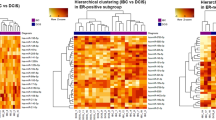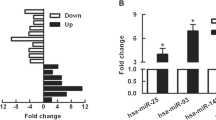Abstract
MicroRNA-21 (miR-21) overexpression is characteristic for various types of tumors, but it is still unknown whether its expression levels differ between invasive and non-invasive breast carcinomas. The main goal of the study was to determine the difference in miR-21 expression among normal tissue, non-invasive, invasive with non-invasive component, and pure invasive breast cancer samples, to explain its potential role and significance in breast cancer invasiveness. The second goal was to propose miR-21 as molecular marker of breast cancer invasiveness and potential target for future anti-miR therapies for the prevention of invasion and metastasis. In order to reveal the role of miR-21 in breast cancer invasiveness, we measured miR-21 expression levels in 44 breast cancer and four normal samples by stem-loop real-time RT-PCR using TaqMan technology. Relative expression levels of miR-21 were significantly higher in invasive than in other groups (P = 0.002) and significantly higher in invasive compared with invasive with non-invasive component group in histological (P = 0.043) and nuclear grade 2 (P = 0.036), estrogen-receptor-positive (ER+) (P = 0.006), progesterone-receptor-positive (PR+) (P = 0.008), ER+PR+ (P = 0.007), and proliferation index (Ki-67) ≤ 20 % (P = 0.036) tumors. Our findings suggest that miR-21 could be independent molecular marker of breast cancer invasiveness and potential target for future anti-miR therapies for the prevention of invasion and metastasis.


Similar content being viewed by others
References
Verkooijen HM, Fioretta GR, Vlastos G, Morabia A, Schubert H, Sappino A-P, et al. Important increase of invasive lobular breast cancer incidence in Geneva. Switzerland. Int J Cancer. 2003;104:778–81.
Bair EL, Chen ML, McDaniel K, Sekiguchi K, Cress AE, Nagle RB, et al. Membrane type 1 matrix metalloprotease cleaves laminin-10 and promotes prostate cancer cell migration. Neoplasia. 2005;7:380–9.
Ma L, Weinberg RA. Micromanagers of malignancy: role of microRNAs in regulating metastasis. Trends Genet. 2008;24:448–56.
Xia M, Hu M. The role of microRNA in tumor invasion and metastasis. J Cancer Mol. 2010;5:33–9.
Farabegoli F, Champeme MH, Bieche I, Santini D, Ceccarelli C, Derenzini M, et al. Genetic pathways in the evolution of breast ductal carcinoma in situ. J Pathol. 2002;196:280–6.
Wong H, Lau S, Yau T, Cheung P, Epstein RJ. Presence of an in situ component is associated with reduced biological aggressiveness of size-matched invasive breast cancer. B J Cancer. 2010;102:1391–6.
Hannemann J, Velds A, Halfwerk JBG, Kreike B, Peterse JL, van de Vijver MJ. Classification of ductal carcinoma in situ by gene expression profiling. Breast Cancer Res. 2006;8:61–80.
Chuang JC, Jones PA. Epigenetics and microRNAs. Pediatr Res. 2007;61(5 Part 2):24R.
Wu W, Lin Z, Zhuang Z, Liang X. Expression profile of mammalian microRNAs in endometrioid adenocarcinoma. Eur J Cancer Prev. 2009;18:50–5.
Shenouda SK, Alahari SK. MicroRNA function in cancer: oncogene or a tumor suppressor? Cancer Metastasis Rev. 2009;28:369–78.
Song B, Wang C, Liu J, Wang X, Lv L, Wei L, et al. MicroRNA-21 regulates breast cancer invasion partly by targeting tissue inhibitor of metalloproteinase 3 expression. J Exp Clinl Cancer Res. 2010;29:29–36.
Huang G-L, Zhang X-H, Guo G-L, Huang K-T, Yang K-Y, Shen X, et al. Clinical significance of miR-21 expression in breast cancer: SYBR-Green I-based real-time RT-PCR study of invasive ductal carcinoma. Oncol Rep. 2009;21:673–9.
Lee JA, Lee HY, Lee ES, Kim I, Bae JW. Prognostic implications of microRNA-21 overexpression in invasive ductal carcinomas of the breast. J Breast Cancer. 2011;14:269–75.
Zhu S, Si ML, Wu H, Mo YY. MicroRNA-21 targets the tumor suppressor gene tropomyosin 1 (TPM1). J Biol Chem. 2007;282:14328–36.
Yang Y, Chaerkady R, Beer MA, Mendell JT, Pandey A. Identification of miR-21 targets in breast cancer cells using a quantitative proteomic approach. Proteomics. 2009;9:1374–84.
Span PN, Lindberg RLP, Manders P, Tjan-Heijnen VCG, Heuvel JJTM, Beex LVAM, et al. Tissue inhibitors of metalloproteinase expression in human breast cancer: TIMP-3 is associated with adjuvant endocrine therapy success. J Path. 2004;202:395–402.
Mylona E, Magkou C, Giannopoulou I, Agrogiannis G, Markaki S, Keramopoulos A, et al. Breast Cancer Res. 2006;8:R57–64.
Lopez-Camarillo C, Fonseca-Sánchez MA, Flores-Pérez A, Marchat LA, Arechaga-Ocampo E, Azuara-Liceaga E, et al. Functional roles of microRNAs in cancer: microRNomes and oncomiRs connection. In: Lopez-Camarillo CAL, Arechaga-Ocampo E, Azuara-Liceaga E, Perez Plasencia C, Fuentes-Mera L, et al., editors. Oncogenomics and cancer proteomics—novel approaches in biomarkers discovery and therapeutic targets in cancer. InTech; 2013. p. 72–89.
Yoshinaga H, Matsuhashi S, Fujiyama C, Masaki Z. Novel human PDCD4 (H731) gene expressed in proliferative cells is expressed in the small duct epithelial cells of the breast as revealed by an anti-H731 antibody. Pathol Int. 1999;49:1067–77.
Frankel LB, Christoffersen NR, Jacobsen A, Lindow M, Krogh A, Lund AH. Programmed cell death 4 (PDCD4) Is an important functional target of the microRNA miR-21 in breast cancer cells. J Biol Chem. 2007;283:1026–33.
Yu Z, Baserga R, Chen L, Wang C, Lisanti MP, Pestell RG. microRNA, cell cycle, and human breast cancer. Am J Path. 2010;176:1058–64.
Tang J, Ahmad A, Sarkar FH. The role of microRNAs in breast cancer migration, invasion and metastasis. Int J Mol Sci. 2012;13:13414–37.
Leake R. Immunohistochemical detection of steroid receptors in breast cancer: a working protocol. J Clin Pathol. 2000;53:634–5.
Sauter G, Lee J, Bartlett JMS, Slamon DJ, Press MF. Guidelines for human epidermal growth factor receptor 2 testing: biologic and methodologic considerations. J Clin Oncol. 2009;27:1323–33.
Iorio MV, Ferracin M, Liu CG, Veronese A, Spizzo R, Sabbioni S, et al. MicroRNA gene expression deregulation in human breast cancer. Cancer Res. 2005;65:7065–70.
Si ML, Zhu S, Wu H, Lu Z, Wu F, Mo YY. MiR-21-mediated tumor growth. Oncogene. 2006;26:2799–803.
Li J, Zhang Y, Zhang W, Jia S, Tian R, Kang Y, et al. Genetic heterogeneity of breast cancer metastasis may be related to miR-21 regulation of TIMP-3 in translation. Int J Surg Oncol. 2013;2013:1–7.
Liu YE. Preparation and characterization of recombinant tissue inhibitor of metalloproteinase 4 (TIMP-4). J Biol Chem. 1997;272:20479–83.
Qian B, Katsaros D, Lu L, Preti M, Durando A, Arisio R, et al. High miR-21 expression in breast cancer associated with poor disease-free survival in early stage disease and high TGF-β1. Breast Cancer Res Treat. 2008;117:131–40.
Si H, Sun X, Chen Y, Cao Y, Chen S, Wang H, et al. Circulating microRNA-92a and microRNA-21 as novel minimally invasive biomarkers for primary breast cancer. J Cancer Res Clin Oncol. 2012;139:223–9.
Kumar SKR, Pazhanimuthu A, Perumal P. Overexpression of circulating miRNA-21 and miRNA-146a in plasma samples of breast cancer patients. Indian J Biochem Biophys. 2013;50:210–4.
Kumarswamy R, Volkmann I, Thum T. Regulation and function of miRNA-21 in health and disease. RNA Biol. 2011;8:706–13.
Acknowledgments
This work was supported by the Ministry of Education and Science, Republic of Serbia, Grant ON173049 (Nina Petrović, Vesna Mandušić, Boban Stanojević, Silvana Lukić, Lidija Todorović, Bogomir Dimitrijević). We thank Radoslav Davidović for valuable technical support.
Conflict of interest
All authors declare that they have no conflict of interest.
Author information
Authors and Affiliations
Corresponding author
Electronic supplementary material
Below is the link to the electronic supplementary material.
Rights and permissions
About this article
Cite this article
Petrović, N., Mandušić, V., Stanojević, B. et al. The difference in miR-21 expression levels between invasive and non-invasive breast cancers emphasizes its role in breast cancer invasion. Med Oncol 31, 867 (2014). https://doi.org/10.1007/s12032-014-0867-x
Received:
Accepted:
Published:
DOI: https://doi.org/10.1007/s12032-014-0867-x




